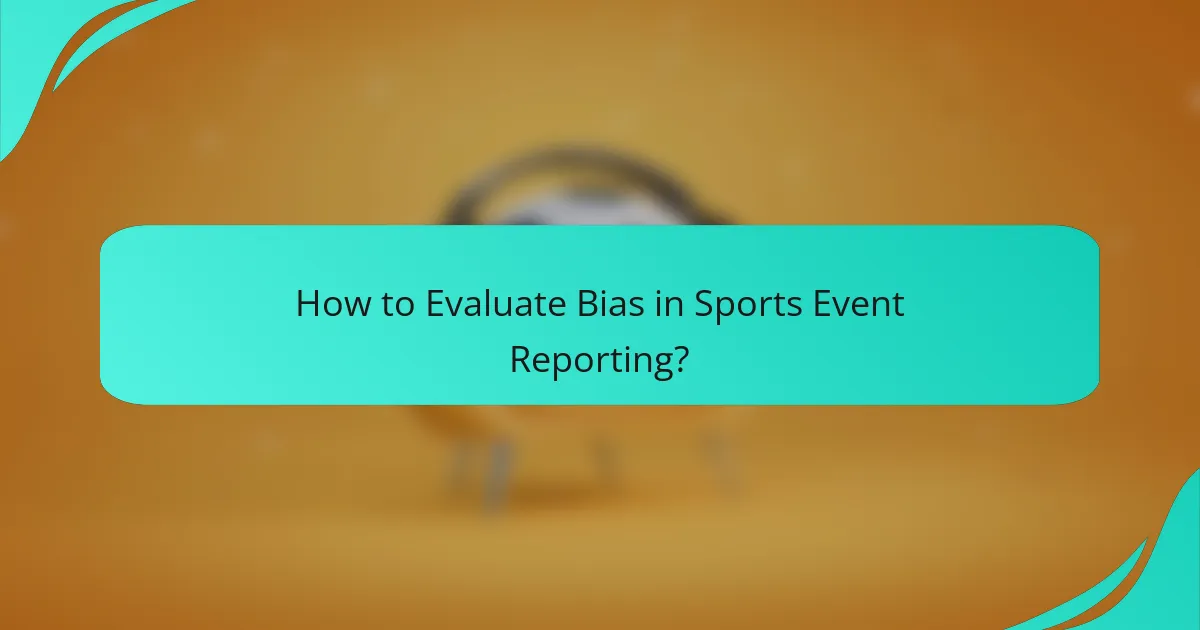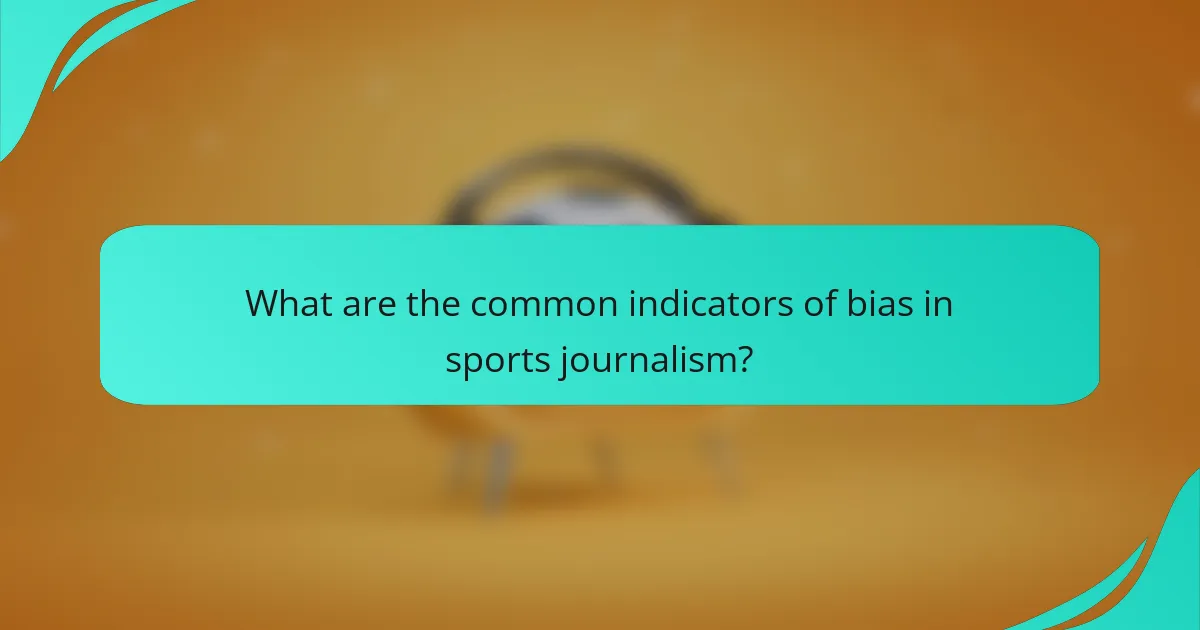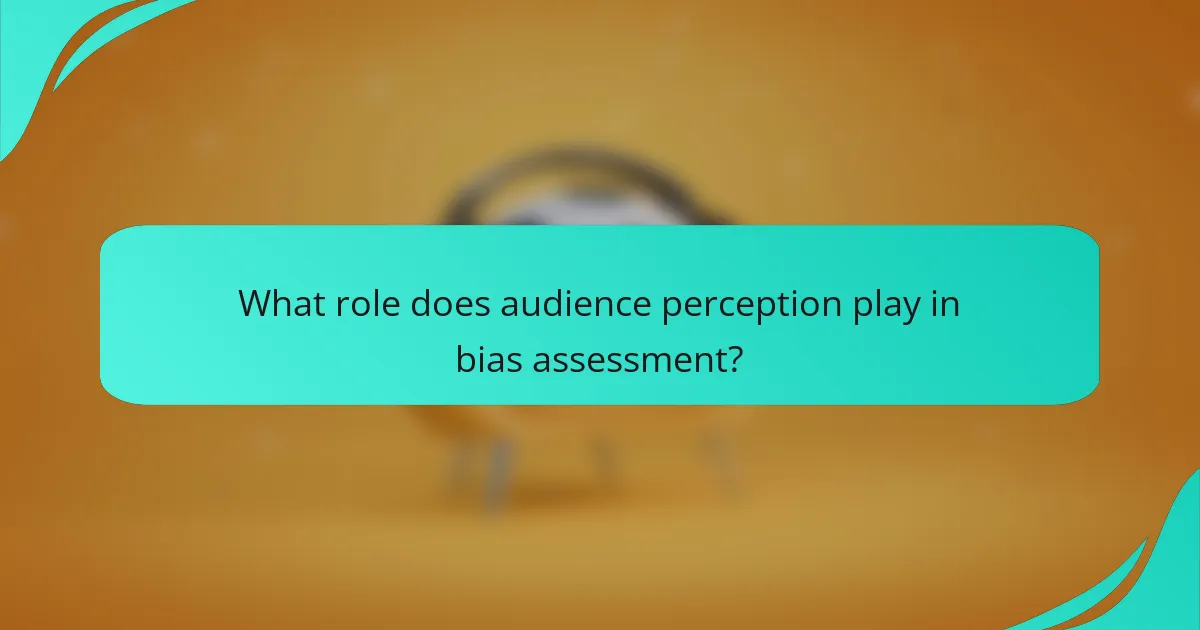Bias assessment in sports event reporting is crucial for ensuring fair and accurate coverage. By analyzing language, sources, and narratives, we can uncover potential partiality that may skew public perception. Journalists can promote objectivity by adhering to rigorous reporting standards and incorporating diverse viewpoints, ultimately fostering a more balanced understanding of sports events.

How to Evaluate Bias in Sports Event Reporting?
Evaluating bias in sports event reporting involves assessing the language, sources, statistics, expert opinions, and comparisons across multiple reports. This process helps identify potential partiality and ensures a more balanced understanding of the events covered.
Identify language and tone
Language and tone are critical indicators of bias in reporting. Look for emotionally charged words or phrases that may indicate favoritism towards a team or player. For instance, describing a player as “heroic” versus “lucky” can reveal underlying biases.
Additionally, consider the overall tone of the article. A consistently negative or positive tone towards a particular team can signal a lack of objectivity. Aim for neutrality in reporting, where both sides of a story are presented fairly.
Analyze source diversity
Diverse sources enhance the credibility of sports reporting. Evaluate whether the article includes perspectives from various stakeholders, such as players, coaches, and analysts. A report relying solely on one source may reflect a biased viewpoint.
To ensure balanced coverage, check if the reporting includes voices from different teams or regions. For example, if a report on a championship game only features one team’s perspective, it may lack objectivity.
Examine statistical representation
Statistics can be manipulated to support biased narratives. When evaluating sports reporting, scrutinize how statistics are presented. Are they contextualized with relevant comparisons, or are they cherry-picked to favor one side?
For instance, highlighting a player’s scoring average without mentioning the number of games played can mislead readers. Look for comprehensive data that provides a fuller picture of performance and context.
Review expert opinions
Expert opinions can lend authority to sports reporting, but they can also introduce bias. Assess whether the experts cited have a history of impartiality or if they are known for their allegiance to a particular team or player.
Consider the range of expert opinions presented. A report that includes a variety of viewpoints is more likely to provide a balanced perspective than one that only features experts with similar biases.
Compare multiple reports
Comparing multiple reports on the same event is one of the most effective ways to identify bias. Look for discrepancies in how different outlets cover the same game or incident. Variations in focus, language, and source diversity can reveal underlying biases.
When comparing reports, note which aspects are emphasized or downplayed. This can help you discern which narratives may be skewed and encourage a more nuanced understanding of the event.

What are the common indicators of bias in sports journalism?
Common indicators of bias in sports journalism include selective reporting, framing techniques, and overemphasis on certain narratives. These elements can significantly influence public perception and understanding of sports events.
Selective reporting
Selective reporting occurs when journalists highlight specific facts or events while ignoring others, creating a skewed representation of the situation. For instance, a reporter might focus solely on a team’s victories without mentioning their losses, leading to an overly positive portrayal.
To identify selective reporting, consider whether the coverage presents a balanced view of all relevant aspects. Look for articles that include multiple perspectives, especially in controversial situations, to gauge fairness.
Framing techniques
Framing techniques shape how a story is perceived by emphasizing certain elements over others. For example, using emotionally charged language can influence readers’ feelings about a player or team, such as describing a last-minute loss as a “devastating blow” rather than a “tough match.”
To assess framing, pay attention to the language used and the context provided. Headlines that evoke strong emotions or focus on specific incidents can indicate a biased perspective.
Overemphasis on certain narratives
Overemphasis on certain narratives refers to the tendency to repeatedly highlight specific themes or storylines, which can distort the overall picture. For example, if a journalist consistently portrays a player as a “comeback hero,” it may overshadow other important aspects of their performance.
To recognize this bias, look for patterns in reporting. If certain narratives dominate coverage while others are neglected, it may indicate an intentional bias that skews the audience’s understanding of the events.

How can sports journalists improve objectivity?
Sports journalists can enhance objectivity by adhering to rigorous standards of reporting, ensuring that their coverage is balanced and fact-based. This involves implementing structured processes for verifying information and actively seeking diverse perspectives to minimize bias.
Implement fact-checking protocols
Fact-checking protocols are essential for maintaining accuracy in sports reporting. Journalists should establish a clear process for verifying statistics, quotes, and events before publication. This can include cross-referencing multiple reliable sources and utilizing established databases for sports statistics.
Common pitfalls include relying on unverified social media posts or anecdotal evidence. Journalists should avoid these by adhering to a checklist that includes confirming the credibility of sources and ensuring that all claims are substantiated by factual data.
Diverse sourcing practices
Diverse sourcing practices involve gathering information from a wide range of voices, including players, coaches, analysts, and fans. This approach helps to present a more comprehensive view of events and reduces the risk of bias that can arise from a narrow perspective.
To implement this, journalists can create a sourcing strategy that includes reaching out to underrepresented groups or communities. For example, including insights from women athletes or minority coaches can enrich the narrative and provide a fuller understanding of the sports landscape.
Training on bias recognition
Training on bias recognition equips journalists with the skills to identify and mitigate their own biases in reporting. Workshops and seminars can be effective in raising awareness about common biases, such as confirmation bias or cultural bias, that may influence coverage.
Regular training sessions can include practical exercises, such as analyzing past articles for bias or discussing case studies. Journalists should also be encouraged to seek feedback from peers to continuously improve their objectivity in reporting.

What tools assist in bias assessment for sports reporting?
Several tools can help evaluate bias in sports reporting, providing insights into the objectivity of coverage. These tools include media bias charts, sentiment analysis software, and fact-checking websites, each serving a unique purpose in assessing the fairness and accuracy of sports news.
Media bias charts
Media bias charts visually represent the political bias and reliability of various news outlets, including those covering sports. They categorize sources along a spectrum from left to right, helping readers identify potential biases in reporting. For example, a chart might show that a particular sports news website has a left-leaning bias, prompting readers to consider how that may influence its coverage of events.
When using media bias charts, it’s essential to cross-reference multiple sources to get a balanced view. Relying solely on one chart may not provide a complete picture of an outlet’s bias. Always check for the most recent updates, as media bias can shift over time.
Sentiment analysis software
Sentiment analysis software uses algorithms to evaluate the emotional tone of articles and reports, helping to identify bias in sports journalism. These tools analyze language patterns to determine whether the sentiment is positive, negative, or neutral. For instance, a sports article that predominantly uses negative language about a team may indicate bias against that team.
When employing sentiment analysis, consider the context of the language used. A critical piece may be justified based on performance, while overly emotional language could signal bias. Combining sentiment analysis with qualitative reviews provides a more comprehensive assessment of bias.
Fact-checking websites
Fact-checking websites play a crucial role in verifying claims made in sports reporting, helping to assess the accuracy of information presented. These platforms evaluate statements made by journalists and athletes, providing evidence-based conclusions about their truthfulness. For example, if a sports commentator claims a player has the highest scoring average, a fact-checking site can confirm or refute that claim.
Utilizing fact-checking websites is essential for maintaining an informed perspective on sports news. Always look for reputable sources that adhere to established fact-checking standards. Be cautious of sites that lack transparency in their methodology, as this can affect the reliability of their assessments.

What role does audience perception play in bias assessment?
Audience perception significantly influences bias assessment by shaping how sports event reporting is interpreted. When audiences perceive coverage as biased, it can affect their trust in the media and the overall credibility of the reporting.
Influence of social media
Social media platforms amplify audience perceptions of bias by allowing immediate feedback and discussion. Fans often share their opinions on coverage, which can quickly sway public sentiment and highlight perceived biases in reporting.
For example, if a major sports event is covered predominantly from one team’s perspective, social media users may express dissatisfaction, leading to a broader conversation about fairness in reporting. This feedback can pressure media outlets to adjust their coverage to maintain credibility.
Feedback mechanisms
Feedback mechanisms, such as surveys and comment sections, provide direct insights into audience perceptions of bias. Media organizations can use these tools to gauge public opinion and identify areas where their reporting may be seen as one-sided.
Implementing regular audience feedback can help sports reporters understand how their coverage is received and make necessary adjustments. For instance, if a survey reveals that a significant portion of the audience feels a particular event was underreported, the outlet can address this in future coverage to enhance objectivity.
